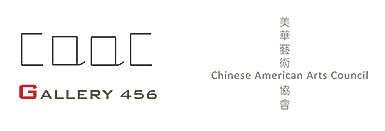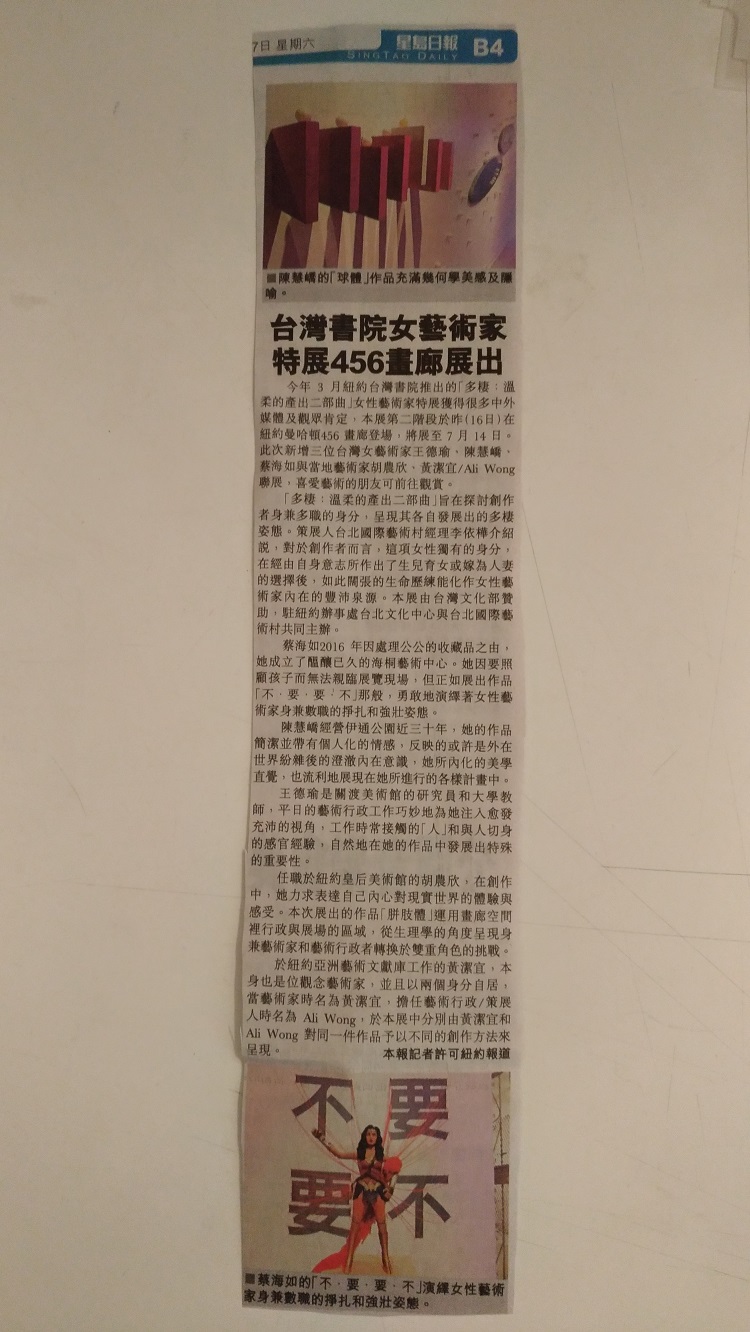| 2017.7.4 | ArtAsiaPacific Review by MIMI WONG ....點選更多訊息The “Considerate Creations: Chameleons” exhibition series, which opened at the Taipei Cultural Center in New York this spring, expanded on the topic of working women artists by highlighting yet another dimension in its second edition: motherhood. While preparing for the presentation at Gallery 456, Taiwanese curator Lee I-Hua shared the news that she was three months pregnant, which added an unexpected, personal significance to the show. The role of a mother is just one of many that female artists inevitably inhabit, according to Lee, who sees the “chameleon artist” as a global phenomenon.
Fellow Taiwanese artist Tsai Hai-Ru illustrates the often-contradictory nature of those various roles in No.Yes.Yes.No. (2016). The Chinese phrases “buyao/yaobu” (“不要/要不”), which can be associated with negotiation or compromise, were affixed to the wall. Red string was attached to each character, and the strands joined together to form a single braid—a burden carried by a Wonder Woman action figure. In an earlier installation of the work, instead of using a pedestal, the artist placed the figurine on the floor. As a result, Wonder Woman often fell over, becoming entangled in the string. Tsai has said that she feels the scenario without the pedestal more accurately resembles her intentions for the piece.
Dueling parts of the self also manifest in Hu Nung-Hsin’s Corpus Callosum (2017), named for the bundle of nerves that joins the two hemispheres of the brain. Hu centers the installation around an actual wall to literalize this division; on each side, she has woven into the wall a live coconut plant as a stand-in for nerve fibers. Above each plant hangs a motion-activated grow light, which can only be triggered from the opposite side of the wall, mimicking how the left-side of our brain controls the right-half of our body, and vice versa. In addition, the two halves correlate to different modes of thinking, such as analytical versus imaginative, and verbal versus visual. Speech itself becomes a tug-of-war for the bilingual artist, who included video recordings of language-learning exercises in order to emphasize the corpus callosum’s function as the conduit between her two selves.
Hong Kong-born Wong Kit Yi goes one step further by divorcing her artistic persona from her professional one, known as Ali Wong. In her second collaboration with composer Kyle Oppenheimer, the conceptual artist expresses her two alter egos through song. The first track “Lunatic” by Wong Kit Yi reads like free association poetry that traces historical and literary associations of the word as ascribed to femininity. The second track “Moonquake,” penned under her professional moniker, opens with lunar facts spoken over Debussy’s “Clair de Lune” (1905), then transitions to upbeat, electronic pop that unpacks the moon as a feminine trope: “soft, gentle, mysterious, passive / (receiving its light from the masculine / sun), orbiting about the earth as a woman / orbits about her man and her family.” Yet Wong’s lyrics purposefully move beyond the domestic space, articulating how the “stereotype of woman has been / molded by history, culture, society.” The installation concludes with an exploration of her “double” identity in a third song called I am Two People by both Wong Kit Yi and Ali Wong.
Chen Hui-Chiao’s The Silver Dust #3 (2010) similarly draws inspiration from celestial bodies by alluding to their orbits in what would otherwise appear to be randomly scattered ping pong balls. The movement of these “planets” and “stars” is meant to parallel civilization’s political and social movements, while nodding to the limitlessness of the universe. The ping pong balls reappear in Between Us (2016), this time balanced upon steel bars, positioned up and down on a figurative scale like notes on sheet music. Chen deliberately coordinated the magenta color of the bars to match that of Wang Te-Yu’s No. 89 (2017), which features a large, balloon-like structure. The interactive nature of the two works reflects not only the artists’ history of collaboration but also Wang’s interest in creating pieces that engage the viewer and invite their participation.
Just as the biographies and resumes of the artists in “Considerate Creations: Chameleons Part II” showcase the various identities they assume on daily basis, the perception as to whether or not these are in competition with one another, or working harmoniously in tandem, varies equally from person to person. It is this pursuit to understand the individual artist’s role in a greater societal context that unifies the seemingly disparate works.
....點選更多訊息
|
| 2017.6.19 | [MSN] 紐約台灣月藝術展 多棲主題二部曲 ....點選更多訊息(中央社記者黃兆平紐約18日專電)紐約台北文化中心「台灣月」活動展開。結合多位台灣女性藝術家的「多棲:溫柔的產出二部曲」展覽,透過錄像、裝置、雕塑等多元媒材,傳達特有的創作視角與人文關懷。
「多棲」首部曲受到媒體及觀眾肯定,這次增添3位台灣女藝術家王德瑜、陳慧嶠、蔡海如,與旅美藝術家胡農欣、黃潔宜共同聯展,為台灣月活動增色升溫。
「多棲:溫柔的產出二部曲」6月16日起到7月14日在紐約曼哈頓下城區456畫廊登場,探討創作者身兼數職身分,呈現各自發展的多棲姿態。
5位女性藝術家身兼雙重角色的多職狀態,代表夢想實行必需涵蓋的角色及條件,在肯定藝術的同時,也期待溫柔產出,帶給觀眾更多面向思考和不同層面價值判斷。
策展人、藝評李依樺認為,「多棲」藝術家的各種身分中,母職角色是男性無法企及。對於創作者而言,這項女性獨有身分,經由自身意志作出生兒育女或嫁為人妻的選擇後,擴張的生命歷練,化作女性藝術家的豐沛創作泉源。
....點選更多訊息
|
| 2017.6.18 | [China Press/侨报] 台湾书院《多栖:温柔的产出二部曲》特展开幕 ....點選更多訊息【侨报记者陈辰6月17日纽约报道】由纽约台湾书院推出的《多栖:温柔的产出二部曲》女性艺术家特展16日于曼哈顿下城456画廊开幕。展览以女艺术家们来自不同层面的丰富视角,呈现当代女性在社会发展中展现的多栖姿态。
由6位女性艺术家作品组成的名为《多栖:温柔的产出二部曲》的艺术特展16日于456画廊开幕,现场通过展出旅居纽约的台、港年轻女性艺术家不同型态的艺术创作,探讨及提升女性在现代社会的地位以及重要性。
根据本展策展人李依桦介绍,本次展览是两年前《温柔的产出》展览的延伸,将讨论的背景从台湾的艺文环境延伸至美国纽约。展览将以“二部曲”方式呈现,一部曲首先于3月在台湾书院登场,邀请胡农欣、邱于真、黄洁宜三位现居纽约从事多职艺文工作的台、港女性艺术家参展。
李依桦表示,本次展出的“二部曲”以装置艺术为主。参加者包括胡农欣、邱于真、黄洁宜三位现居纽约从事多职艺文工作的台、港女性艺术家。同时,邀请台湾艺术家陈慧峤、王德瑜、蔡海如的作品加入展出,为展览带来更加多元化与故事性的艺术叙述,在探讨创作者需身兼数职的多重身份之余,也触及女性艺术家在婚姻和家庭中的母职与亲职角色,呈现女性各自发展出的多栖姿态。
“我在策展时怀有身孕,仿佛身体力行实践女性艺术工作者所需面对的母职角色,我将这项亲身参与视为某种艺术行动,在身兼艺术家和艺术行政工作者的同时,更努力成为一位母亲。” 李依桦表示。
艺术家蔡海如表示,在成为人母之后,她不同于自我满足的过往创作模式,逐渐把创作当作拓展自身与外界沟通、连结的介面。在母亲与家长等多重角色中,她的目标并不仅止于创作,透过艺术空间的成立,也希望转化社会与生活中不易碰触的事物议题。
任职于纽约皇后美术馆的胡农欣,在创作中力求表达自己内心对现实世界的体验与感受。因在皇后美术馆从事社区艺术教育的工作,使得她的作品由最初以切身经验出发,表达女性独自在异乡的视角和观察,逐渐转向对多元文化的关心和学习。
本次展览于6月16日至7月14日在曼哈顿百老汇456号3楼456画廊展出,欢迎广大艺术爱好者到场观赏。
....點選更多訊息
|
| 2017.6.18 | [CNA/中央社] 「多棲」Part ll推五位女藝術家聯展 為臺灣月增色升溫 ....點選更多訊息(中央社訊息服務20170619 17:57:18)今年3月紐約臺灣書院推出「多棲:溫柔的產出二部曲」女性藝術家特展獲得很多中外媒體及觀眾肯定,第二階段展出於6月16至7月14日在紐約曼哈頓下城區456畫廊登場,此次增添三位臺灣女藝術家王德瑜、陳慧嶠、蔡海如與當地藝術家胡農欣、黃潔宜/Ali Wong聯展,為紐約臺北文化中心臺灣月活動增色升溫。
《多棲:溫柔的產出二部曲》旨在探討創作者身兼多職的身份,呈現其各自發展出的多棲姿態。策展人臺北國際藝術村經理李依樺在策展時,同時也是孕婦身份,彷彿身體力行實踐女性藝術工作者所需面對的母職角色,在“多棲”藝術家的各種身份中,母職這個角色是男性所無法企及的。
蔡海如2016年成立了海桐藝術中心,在母職、親職及經營藝術空間等多重角色中努力,她彷彿展出作品〈不.要.要.不〉女超人那般,勇敢地演繹著女性藝術家身兼數職的掙扎和強壯姿態。
陳慧嶠經營伊通公園近三十年,她的作品簡潔並帶有個人化的情感。王德瑜是關渡美術館的研究員和大學教師,平日的藝術行政工作巧妙地為她注入愈發充沛的視角。任職於紐約皇后美術館的胡農欣,本次展出的作品〈胼肢體〉運用畫廊空間裡行政與展場的區域,從生理學的角度呈現身兼藝術家和藝術行政者轉換於雙重角色的挑戰。於紐約亞洲藝術文獻庫工作的黃潔宜,本身是觀念藝術家也是策展人,擔任藝術行政及策展人時名為Ali Wong,以此雙重角色在各項創作中貫徹她的藝術實踐。
本展藝術家身兼雙重角色的多職狀態,代表了夢想實行所必需涵蓋的角色及條件,在肯定藝術的同時,也期待溫柔產出的各種姿態,皆能帶來更多面向的思考和不同層面的價值判斷,尤其向這些溫柔的多棲藝術家致敬。本展由中華民國文化部贊助,駐紐約辦事處臺北文化中心與台北國際藝術村共同主辦,協辦單位包括紐約inCube Arts藝術中心與美華藝術協會456畫廊。
....點選更多訊息
|
| 2017.6.17 | [World Journal/世界新聞網] 5台藝術家聯袂 展多棲女性視角 ....點選更多訊息由台灣女藝術家聯合展出的「多棲:溫柔的產出二部曲」即日起在曼哈頓456畫廊展出,參展者包括王德瑜、陳慧嶠、蔡海如、胡農欣以及黃潔宜。策展人李依樺表示,女性藝術工作者在社會中有很多身分,包括母親、藝術家、其他從業者等,「這次的作品就是展現多棲藝術家女性視角」。
現任台灣關渡美術館的研究員和大學教師王德瑜表示,她這次參展的互動作品從外觀上看是巨大氣囊,觀者可體會從外觀看和走進內部感受截然不同,體現轉換空間與人的主體/客體關係,而觀者感官、視覺體驗也是互動展品的一部分。氣囊的柔軟材質和流動性也表現出女性溫柔而堅定,包容而大度的特質。
陳慧嶠經營台北伊通街藝術空間「伊通公園」近30年,她表示,參展作品以乒乓球為主要表現媒材,靈感來自於幾何學和物理學,運用抽象幾何的表現手法和極簡單色的表現形式,呈現形而上學的哲學討論。通過多年在不同角色轉換的歷練,作品表現出平衡、淡然的狀態。
藝術家蔡海如身為人母,需要照顧孩子,分身乏術,無法親赴展覽現場。這次參展的作品名為「不.要.要.不」,從她的作品能看出作為一名女性身兼數職面臨的挑戰、掙扎以及獨當一面的堅毅和強大。
胡農欣任職於紐約皇后美術館(Queens Museum),作品通過腦部神經束活動、左右腦轉化的抽象展示,抽象卻形象生動地表現出女藝術家在不同身分之間的轉換。
觀念藝術家和亞洲藝術文獻庫工作者的黃潔宜帶來以月亮為靈感的參展作品,她表示,「我們對月亮的既定印象是溫柔、被動和害羞,但是月亮卻是多面的。女性就像月亮一樣,並不是只有看上去的一面,而是多面的,多層次的」。
「多棲:溫柔的產出二部曲」展覽從6月16日至7月14日,周一至周五下午1時到6時開放,展出地點456畫廊,地址為百老匯大道456號三樓。
....點選更多訊息
|
| 2017.6.17 | [Sing Tao Daily/星島日報] 台灣書院女藝術家特展456畫廊展出 ....點選更多訊息 |
| 2017.6.13 | [MingPao/明報] 台灣女藝術家特展 ....點選更多訊息(明報13日訊)紐約台灣書院推出「多棲:溫柔的產出二部曲」女性藝術家特展第二階段即將於6月16至7月14日在紐約曼哈頓下城區456畫廊登場,此次增添三位台灣女藝術家王德瑜、陳慧嶠、蔡海如與當地藝術家胡農欣、黃潔宜/Ali Wong聯展,為紐約台北文化中心台灣月活動增色升溫,透過錄像、裝置、雕塑等多元媒材傳達女性藝術家特有的創作視角與人文關懷,歡迎喜愛藝術的朋友前往觀賞。
時間:2017年6月16日至7月14日,週一至週五下午1時至6時
地點:美華藝術協會/456畫廊(456 Broadway, 3rd Floor, New York, NY 10013, USA)
....點選更多訊息
|

